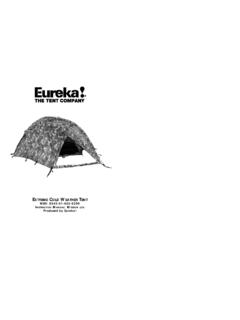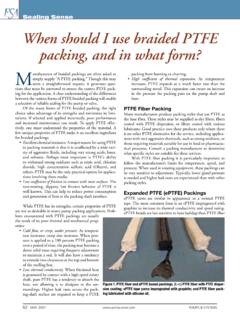Transcription of A guide to proper installation and sealing
1 A guide to proper installation and sealing By IBS Advisors, LLC. San Antonio, TX. Copyright 2007 by Brett Dillon & IBS Advisors, LLC. This work is copyright protected and no portion may be reproduced, copied, duplicated, stored in a retrieval system, or transmitted by any means (electronic, mechanical, photocopying, recording or any other means) without the express written permission of the copyright holder. Copyright 2007, Brett Dillon & IBS Advisors, LLC. Copyright 2007 by Brett Dillon & IBS Advisors, LLC. Manual D. Manual D is the residential duct design manual that is published by the Air Conditioning Contractors of Association (ACCA). It covers duct types, applications, selections, principles of multi-speed and variable speed blowers, pressure loss, operating point, duct sizing calculations, duct leakage and conduction losses. Ducts should be sized according to the highest load for that zone.
2 Ducts should be laid out in a way that accounts for load zones, structural material, framing orientation and occupant comfort (have you ever had a ceiling register pointed at the bed?). Duct sizing according to Manual D is a code requirement in the 2003 International Residential Code ( ). Ducts are usually made out of one or more of the following: sheet metal, pre-fabricated flex duct, duct insulation board and building cavities. Sheet metal ductwork has a lower friction loss rate than the other types of ducts. Fungi typically won't grow on metal ductwork (although they will grow on the dust and trash that can accumulate in the ductwork!), the installation is usually more expensive, the joints and seams leak unless they are well-sealed, and it must be insulated. Pre-fabricated flex duct took the craftsmanship away from duct design and installation and replaced it with a completely random method of installation .
3 Now, it can be left to the installer to interpret where the duct should go, what size should be used, while rejecting standards in favor of chance and randomness. The odds are stacked against a proper flex duct installation from the beginning because the main advantage of the material (it's cheap) is also the main disadvantage (it's cheap). Flex duct has no seams but tends to leak at the joints- a lot! It is fairly fragile and is easily compressed, pinched, crushed and otherwise abused if it is not respected. Flex duct contains an inner pressure liner and an outer layer of insulation covered with a vapor retarder (usually a shiny foil that also acts as a radiant barrier). In order for flex duct to operate properly, it must be installed properly (straight runs; supported every 5' with at least a 1 wide strap; sag no more than per foot of run; be cut to the proper length; and not be pinched to change direction or make a connection).
4 The code governing flexible duct installation is written by the Air Diffusion Council and is referenced by SMACNA and NAIMA in their installation standards (which the International Code Council, in turn, references in ). Rigid duct insulation board is also used to create ducts by field fabrication. Usually, the pieces are attached to each other by some form of tape and are used to create plenums, trunk lines, and distribution boxes. Duct insulation board is a dense, glass fiber mat that has a shiny foil on the outside. Some manufacturer's make a product that has an inner liner as well that is treated with a mildew and fungi retarder. It must be carefully sealed in order to be airtight, but provides excellent noise control. An ideal duct board would have the foil on both the outside and inside. The last category of duct material is actually not duct material- it is a building cavity that is used as a duct!
5 This can lead to all kinds of issues, such as extreme amounts of duct leakage (wood shrinkage due to temperature and humidity differences), poor insulative characteristics, positive or negative pressure zones may be created within these cavities (driving an increase in house exfiltration or infiltration), and sometimes, other trades don't realize that it is a duct. Many times we find plumbing lines and cable or electrical wires pulled through a site built return (Honestly, I thought it was a chase!), or multiple holes drilled through the duct before it became a duct! BUILDING CAVITIES SHOULD NEVER BE. USED AS DUCTS! Principles of good duct design First, try to get the ductwork inside the building envelope. This reduces the duct leakage to the outside (which has an energy penalty) and generally improves performance. While there is no blatant energy penalty for duct leakage to the Copyright 2007 by Brett Dillon & IBS Advisors, LLC.
6 Inside of the building envelope, it can create a comfort penalty (air not getting where it should) and may create indoor air quality issues by creating specific pressure zones that may draw air from bad sources. Well-sealed ductwork within the building envelope is a priority issue. Getting the ductwork inside the building envelope may simply require redefining the building envelope to include an attic, crawlspace or basement. Perhaps a drop ceiling can be installed in a hallway or a soffit built around the edges of the room. Maybe a special truss design can be used that allows the ductwork to be installed within a conditioned zone of the attic. There are many creative ways (exposed ductwork) to get ductwork inside the conditioned space (and some of them are less expensive than others!). Flow balancing dampers are inexpensive and allow the amount of airflow into a room (or zone) to be altered.
7 They should be installed in the duct at an accessible location upstream of the duct supply register. This may be at the take-off from the trunk or plenum, or may be in-line on the duct run itself. The key is to have the damper installed in an accessible location. Sheet metal elbows should be used for making tight turns. Sheet metal has a lower friction rate than flex duct, making it easier for the proper amount of airflow to reach the register. Flex duct turns should be gradual, with the radius of the turn greater than the diameter of the flex duct. In terms of reducing airflow, every 90 bend is the equivalent of adding 30' or more of straight length to the duct run. Duct runs should not originate within 1 foot of the plenum cap or from the plenum cap itself. Ducts shouldn't originate within 1 foot of the end of a trunk line or from the end of the trunk line.
8 Duct run take-offs should be spaced at least 1 foot apart on the plenum or trunk line. Duct installation As long as the ductwork is installed according to the general principles outlined above, what we are really after here is duct sealing . Duct leakage costs the American consumers around $5 billion per year, wasting the equivalent energy used by 13 million cars per year, and is equal to the estimated annual oil production from the Arctic National Wildlife Refuge. It takes about 7 billion trees to offset the carbon dioxide released by the production of this wasted energy. This is why duct sealing is so important. It has been estimated that by retrofitting duct sealing measures and testing all new duct systems to verify a lower leakage rate, the State of California may be able to prevent having to build a 1 GigaWatt power generation plant. One of the main factors driving the link between duct leakage and efficiency is the location of the leak.
9 Ductwork installed in a conventional attic can drop the efficiency of the system by 50%. When that ductwork is installed in a semi- conditioned buffer zone (unconditioned basements inside the building envelope, inter-floor spaces), the efficiency ranges between 50-100% of the system. Ductwork and air handlers installed in a cathedralized (unvented, insulated along the roofline) attic use about 45% less energy than systems installed in conventional (vented) attics. Ductwork and air handlers installed in cathedralized attics carry a 3-5% energy penalty over systems installed completely inside conditioned space. Ducts are usually sealed with either cloth duct tape , foil tape , foil tape with a UL181 rating, or mastic. Cloth duct tape should not be used to seal duct work. It doesn't work in the lab, it doesn't work in the field, and it just doesn't work anywhere.
10 It may be used to temporarily hold pieces of ductwork together, but cannot be relied upon to seal ductwork. Cloth duct tape should never be found holding ductwork together in new construction, particularly in locations that have adopted the International Codes which require the use of duct tape with a UL181 rating (International Energy Conservation Code ). Copyright 2007 by Brett Dillon & IBS Advisors, LLC. Plain foil tape is also often used ( You can't pull that tape off if you tried! ) by contractors who are unaware of the requirements for a UL181 rating. The foil tapes must be attached to clean, dry surfaces and pressed to remove tiny air bubbles. If they are not installed correctly, leakage can (and will) occur. Foil tape that has a UL181 rating has had to pass an adhesive test for 24 hours and meet flame and smoke spread requirements. There are different types of UL181 listed tape ; the UL181A tape is for duct insulation board and UL181B tape is for flex duct.







